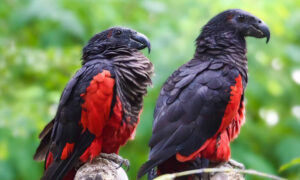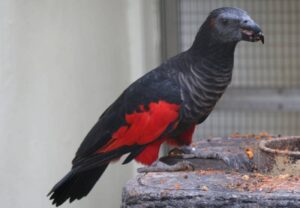The world of birds is teeming with wondrous species that captivate the imagination, but few are as remarkable as the Dracula parrot. This exotic creature, native to the rainforests of New Guinea, has captured the fascination of bird enthusiasts and casual observers alike for its striking appearance and unique behaviors. In this article, we will dive deep into the life of the Dracula parrot, exploring its physical characteristics, habitat, diet, mating rituals, and conservation status. Join us on this journey of discovery as we uncover the legend and wonder of the Dracula parrot.
The Enigmatic Appearance of the Dracula Parrot
When one hears the name “Dracula parrot,” it conjures images of a creature draped in mystery and elegance. Scientifically known as Psittrichas fulgidus, the Dracula parrot is distinguished by its vibrant plumage and striking facial features. Adult Dracula parrots display a rich combination of dark green and bluish feathers, with distinctly vivid red beaks and striking facial markings that resemble the iconic cape of the legendary vampire, Dracula.
This distinct appearance has given rise to its name and its mystique. The Dracula parrot is also characterized by a unique crest that rises from its head, further enhancing its unusual profile. This stunning bird not only possesses beauty but also an air of the extraordinary, making it one of the most sought-after species for birdwatchers and ornithologists.
Habitat: The Lush Rainforests of New Guinea

The Dracula parrot is endemic to the lush rainforests of New Guinea. This habitat provides the ideal environment for the parrot, allowing it to thrive amidst the dense foliage. The subtropical and tropical rainforests not only serve as a home but are rich in biodiversity, providing a diverse array of food sources. Such habitats are critical to the survival of the Dracula parrot, allowing it to flourish in a setting that supports its unique lifestyle.
These rainforests are abundant in fruiting trees, which are vital for the parrot’s diet. The multi-layered canopy provides ample opportunities for foraging and breeding, shielding them from potential predators. However, as deforestation and human encroachment threaten these habitats, the conservation of the Dracula parrot’s environment becomes increasingly important.
Diet
The diet of the Dracula parrot is primarily frugivorous, meaning that they mainly feed on fruits. These vibrant birds have a particular fondness for figs and a variety of other tropical fruits found in their native habitat. The long, curved beak of the Dracula parrot is perfectly adapted for extracting seeds and fruit flesh, allowing it to take advantage of the seasonal bounty available in its rainforest home.
In addition to fruit, the Dracula parrot also consumes seeds, flowers, and occasionally insects. This diverse diet not only sustains the parrot but also plays a role in seed dispersal, contributing to the health of the rainforest ecosystem. As the Dracula parrot feasts on fruits, it inadvertently helps to propagate tree species by spreading their seeds, thus maintaining the delicate balance of its habitat.
Mating Rituals

Mating rituals among the Dracula parrot are as fascinating as the bird itself. During the breeding season, males engage in elaborate courtship displays to attract females. These displays often involve vocalizations, wing flutters, and the showcasing of their vibrant plumage. The interaction between potential mates can be both playful and energetic, emphasizing the bonds that develop between the sexes.
Dracula parrots typically nest in tree cavities, laying a small clutch of eggs. Both parents share the responsibility of incubating the eggs and caring for the young once they hatch. This cooperative breeding behavior exemplifies the strong family bonds within the species. As the chicks grow, they are fed a diet of regurgitated fruit by their parents, further highlighting the nurturing instincts of these captivating birds.
Conservation Status: Threats and Efforts
Despite their stunning beauty and unique traits, the Dracula parrot faces significant threats to its survival. Habitat loss due to logging, agriculture, and urbanization poses the greatest challenge to this species. The destruction of rainforests not only reduces their natural habitats but also diminishes their food sources, making it increasingly difficult for the populations to thrive.
Additionally, illegal pet trading exacerbates the decline of the Dracula parrot population. As demand for exotic pets continues to rise, capturing these magnificent birds from the wild for the pet trade has put further pressure on their numbers. Conservation efforts are critical to ensuring the survival of the Dracula parrot in the wild.
Organizations dedicated to the conservation of New Guinea’s rainforests work tirelessly to protect this remarkable species. Sustainable logging practices, habitat restoration initiatives, and education programs are essential components of conservation strategies aimed at preserving the delicate balance of the rainforest ecosystem in which the Dracula parrot thrives.
Conclusion
The Dracula parrot stands as a remarkable symbol of the biodiversity found in our world’s rainforests. Its unique appearance, fascinating behaviors, and ecological importance make it a creature of both legend and wonder. However, the challenges it faces highlight the urgent need for conservation efforts to protect its habitat and ensure its survival for generations to come.
By embracing our role in wildlife conservation, we can draw attention to the importance of preserving the natural environments that support not only the Dracula parrot but countless species that share this planet with us. As we learn more about these extraordinary birds, let us celebrate their existence and the irreplaceable role they play within our ecosystem.
If you are a bird enthusiast or simply curious about the wonders of nature, the Dracula parrot is a must-see species. From its vivid colors to its interesting behaviors, observing this remarkable bird in its natural habitat is an experience that few will forget. Together, we can work towards a future where the Dracula parrot continues to soar through the lush canopies of New Guinea, a living testament to the beauty and diversity of our planet.

